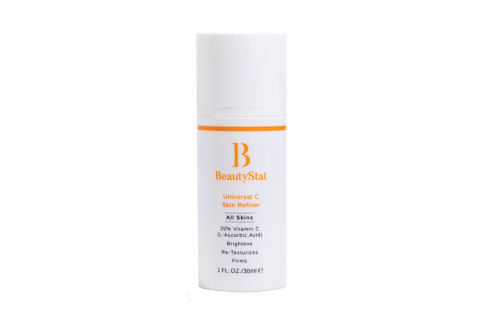How To Build Your Tolerance For Vitamin C Serums, From A Pro

Some of the most popular, top-rated vitamin C serums come with a hefty dose of the nutrient—we're talking 10% to 20% vitamin C. While this brings plenty of benefits for the skin, it's not always easy for folks to use, especially those with sensitive skin.
So, you're often left using a super gentle serum that does contain vitamin C but maybe not enough for you to reap the full potential benefit.
According to cosmetic chemist Ron Robinson, you may just be able to change your fate. Below, the key to using a potent vitamin C serum without upsetting your skin.
Why your skin needs to adjust to vitamin C
The hack, Robinson says, is allowing for an adjustment period and utilizing other products to ease the blow of a strong vitamin C serum. In essence, you want to avoid the common mistake of ramping up too quickly.
He explains that vitamin C can cause sensitivity because, in its active state, it must be at a low pH, or acidic. Your skin's pH is around 5.5, and vitamin C falls below that, causing the two to butt heads if your skin is already sensitized.
"This acidic pH can irritate the skin if your barrier is weak or compromised," he notes. Take particular note—if your skin barrier is not compromised, your skin will better acclimate to vitamin C topically.
This is similar to any active, really—if your skin barrier is already irritated, you're more susceptible to irritation from chemical exfoliants and retinol as well.
So you'll want to make sure your skin barrier is optimized when you start using your vitamin C serum so your skin can properly adjust over time to the new active.
The adjustment protocol
Below, Robinson's suggested protocol to raise your vitamin C tolerance without the negative side effects:
- Use barrier-repair serums for two to four weeks: Before you reach for some 20% vitamin C serum right away, you'll want to get your barrier in tiptop function. To do so, he recommends utilizing a barrier-repair serum in the morning and evening to build up your skin's resilience. Some A+ serums geared toward this goal include The Ordinary Soothing & Barrier Support Serum, the Murad Cellular Hydration Barrier Repair Serum, and the Krave Great Barrier Relief.
- Buffer the vitamin C: After you've done that, it's time to incorporate your goal vitamin C serum. To mitigate the initial chance of irritation, even with a strong barrier, Robinson recommends sandwiching the vitamin C in layers of the barrier serum. Start with once daily, then move to twice daily if your skin can handle it.
- Remove the buffer: Once you've completed the above for another two to four weeks, it's time to remove the buffer put in place. If your skin still meets twice-daily-use with resistance, feel free to dial it back to once daily or keep the barrier around if needed. This adjustment protocol may work for many folks, but some may be hypersensitive and still need the extra support.
Now, depending on your goals, you may not need such a strong vitamin C serum that you have to call upon this adjustment protocol. However, a potent formula can bring great success for anyone searching for noticeable changes in dark spots, brightness, and skin tone—more benefits of topical vitamin C here.
Robinson suggests aiming for somewhere between 10% and 20% but considering a gentler formula to start out if you're new to the ingredient.
If you're ready to start the journey to grow your vitamin C tolerance, pick up a trusty serum. Below, some of the best to consider:
Shop vitamin C serums
The takeaway
If you want to reap the most benefit with the least amount of irritation, you'll have to adjust to your vitamin C serum gradually.
To make the process safer for your skin, spend two to four weeks repairing your skin barrier, another two to four weeks buffering the vitamin C serum with your hydrating serum, and finally, remove the buffer and use your product twice daily if you can. Here, even more vitamin C recommendations and application tips.



